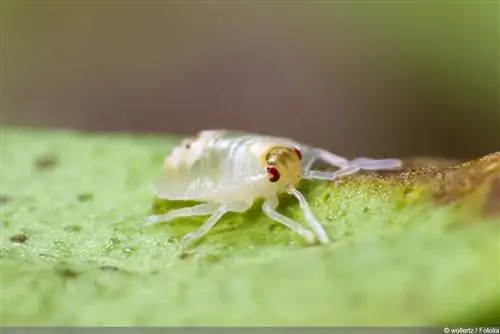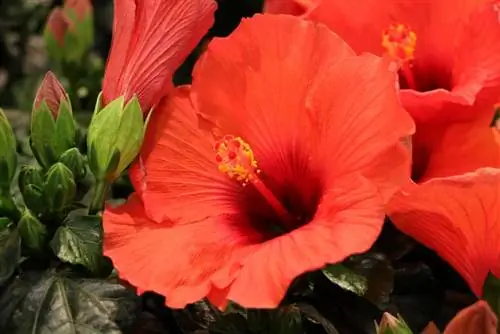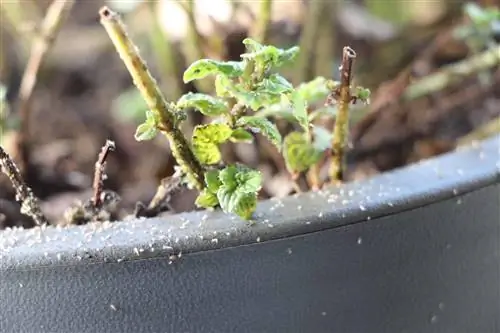- Author admin [email protected].
- Public 2023-12-17 03:39.
- Last modified 2025-01-24 12:45.
The spider mite, which belongs to the mite family (Acari), is found all over the world. In our country, the animals are known primarily as important plant pests. The tiny arachnids are not particularly picky when choosing their host plants and can not only become a huge nuisance for hobby gardeners, but can also cause considerable damage in greenhouses or outdoors.
Combat
The basic rule is: earlier an infestation with spider mites is detected and the earlier you intervene, the easier and more effective the measures are to stop their excessive reproduction. In winter, houseplants lack sunlight. Many also stand directly above the heater in warm rooms. This means unfavorable conditions for the plants, but optimal conditions for the spider mites. Anyone who wants to tackle the pests without chemicals must urgently change these circumstances.
Show off
The affected plant should first be carefully rinsed in the sink, bathtub or shower. The best way to remove pest nests from outdoor plants is to use a sharp jet from the garden hose. For more delicate plants, it is better to use a soft stream of water and, if necessary, wipe the leaves with a sponge or your fingers while rinsing them. It is very important to rinse the undersides of the leaves well in order to manually remove a large part of the spider mite population. It is best to repeat this process every few days.
Cutting
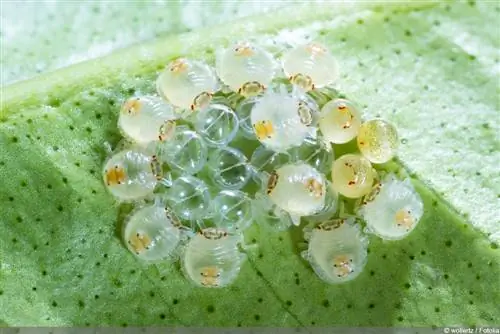
If the pests cannot be removed so easily, it makes sense to cut off all affected parts of the plant. Crops that grow below the infected plant must also be removed as a precaution so that the spider mites cannot spread further. However, do not throw the cutting into the compost, as the plant pests may find an intermediate host there until spring. Ideally, the waste is incinerated or disposed of with household waste.
Increase humidity
After rinsing, houseplants are placed in a transparent plastic bag. Depending on the size, a garbage bag or a yellow bag is sufficient. Place the plant in this bag and spray water into it several times with a spray bottle. Then tie the bag at the top of the plant. The water evaporates in a short time and creates a very high level of humidity inside the bag. Spider mites don't like this condition at all. However, this measure does not harm the plant. Leave the plant in the bag for at least eight to ten days.
Put cooler
Since high temperatures promote the reproduction of spider mites, affected potted plants should be kept a little cooler after the first manual cleaning. The pests stop reproducing at temperatures below 16 degrees.
Proven remedies for spider mites
Spider mites can also be easily combated with home remedies, especially at the beginning of an infestation. In addition to the previously mentioned options for manual removal and increasing the humidity, the following methods have proven successful:
potash soap
A simple remedy against spider mites that is also available inexpensively for hobby gardeners can be made from household soft soap, also known as potassium soap:
- 15 ml liquid potassium soap
- 15 ml spirit
- 1 l water
Mix the components and pour them into a spray bottle. The plants - especially the undersides of the leaves - must be sprayed well with the product at intervals of three to five days. The process is repeated until no more pests are visible.
Rapeseed oil
Rapeseed oil has also become established in the environmentally conscious fight against spider mites in the home and garden. Since rapeseed oil is a foodstuff and is therefore not toxic to humans, animals or plants, it can be used on any type of plant, including fruit trees or vegetable plants. Very small and young plants are an exception, as with the sensitive young plants there is a risk that the fresh shoots will not survive being sprayed with the oily liquid.
- 300 ml rapeseed oil
- 700 ml water
- shake until a milky mixture forms
- Spray plants intensively every three days (at least for two weeks)
Stinging nettle manure

Various manures made from plant material also help against spider mites. Manures are generally made from fresh or dried plant material and poured with cold water. After several days of fermentation in the absence of air, the manure can be used. Before use, solid components are sieved out and the broth is diluted to 1:20 with water. Stinging nettle manure has proven particularly effective against spider mites.
- Use leaves and stems
- collect before flowering
- 100 g fresh nettles per liter of water
- alternatively 20 g dried nettles
- put in a bucket and cover
- let ferment for several days
Onion stock
An onion decoction against spider mites is made from dry onion peels. To do this, pour hot water over a handful of onion peels and let the whole thing steep for about an hour. After straining out the solid components, the broth is diluted 1:10 with water and the infected plant is watered with it.
Tea from field horsetail
Cut about 100 g of fresh horsetail into small pieces and pour them into one liter of water. After an hour, pour the tea through a strainer to remove the pieces. The decoction can be diluted 1:20 with water and sprayed onto the affected plants.
Neem seed tea
The seeds of the neem tree contain a high proportion of essential oil, which can be used to combat spider mites. Neem seeds are available in he alth food stores, pharmacies, well-stocked he alth food stores and drugstores.
- 50 g pressed neem seeds
- Soak overnight in 500 ml of water
- Spray plants with a 1:20 dilution of the filtered solution
Biological agents
Spider mites can also be controlled organically. This is possible using predatory mites (Phytoseiulus persimilis) or lacewings. These predatory mites can be used both outdoors and in greenhouses. Since the predatory mites eat the spider mites in various stages of development, they can be used to successfully combat mass proliferation. In this case, even very hidden pests are reliably detected.
Requirements for use:
- high temperatures: around 25 degrees
- high humidity: around 75%
- particularly suitable for greenhouses
Prevention
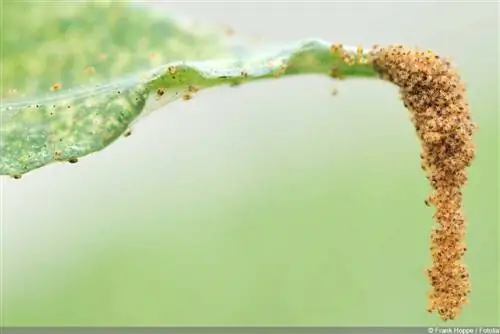
A very effective way to make life difficult for spider mites is to ensure a good microclimate.
Outdoor plants
It is therefore very helpful to always ensure sufficient amounts of water and to keep the plants evenly moist. An additional layer of mulch keeps moisture in the soil longer.
- ensure good moisture balance
- Strengthen plants with potassium-rich fertilizer
- Avoid nitrogen-based fertilizers
- Air greenhouses regularly
- Spray fruit trees and vegetables occasionally with a fine mist of water
Houseplants
To prevent spider mites from spreading in the first place, the humidity in the room should definitely be increased during the cool season. Of course, it's even better to put the plants in a slightly cooler bedroom or guest room.
- Spray plants frequently with the spray bottle
- Hang the evaporator on the heater
- Place a bowl of water on the radiator
- Place the pot in a bowl with stones and water (without root contact with the water)

